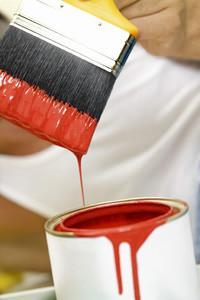Water based enamels
Post from EditorialsThe water based enamels can be used in many applications, both indoors and outdoors.
painting
,
nail polish
,
water
 The acrylic enamels have many advantages. In addition to not require solvents and to be soluble in water, they stretch easily. You can use them on any surface, as long as the surface is not shiny and is clean.
The acrylic enamels have many advantages. In addition to not require solvents and to be soluble in water, they stretch easily. You can use them on any surface, as long as the surface is not shiny and is clean.
The transparent film that is formed when the paint is dry is porous and allows moisture evaporation, avoiding the formation of bubbles.
Acrylic colors are indelible, and the treated surface can be cleaned with a damp sponge.
The water- based enamels can be used in many applications, both indoors and outdoors.
For example, painting with water-based products is much more resistant to fixtures and wood blinds.
In fact this type of paint provides greater resistance to ultraviolet rays and it is easy to maintain.
It is water-repellent, but it leaves the wood to breathe.
Unlike solvent paints doesn't send out bad smell and emits no harmful substances and for this reason can also be used in closed and badly ventilated environments.
The enamels are also ideal for windows and shutters in PVC, for their strength and because they protect surfaces from atmospheric and pollutants agents.
The colors do not yellow and do not lose brilliance. The finish can be as shiny polished and satin or velvet. They wash with soap and water.
 The enamels specific for heating elements, such as radiators in iron or aluminum, are characterized by a very elastic film, resistant to high temperatures.
The enamels specific for heating elements, such as radiators in iron or aluminum, are characterized by a very elastic film, resistant to high temperatures.The enamels are also ideal for gutters and downpipes made PVC or aluminum, because they adhere very well to the substrate.
The iron parts, aluminum or galvanized sheet metal have to be protected, before painting, to prevent the formation of rust.
You can find on the market complete water cycle, including rust, primer and enamel, ideal for gates, grilles and railings. But the water-based products are also ideal to protect and paint wooden furniture for indoor.
Here are the steps for using these products within the reach of anyone with a small familiarity with the DIY:
- Mix the paint before using it and dilute it with water in the time and manner shown on the packaging;
- For wood, wet the surface before sanding. In this way the fibers are raised and the hair can be removed by sanding, avoiding that the phenomenon is present during the painting;
- Between one and the other hand sand several times, so to level the surface and remove the dust;
- Apply the enamel in several coats, but in thin layers, to avoid the paint to wrinkle;
- As soon as you are sure that the product is dry, wait at least 12 hours before applying the next coat;
- After use, tightly seal the paint container and store in a cool, dry place.
 The drying stage is very important, which happens thanks to the evaporation of the water present in the product.
The drying stage is very important, which happens thanks to the evaporation of the water present in the product.The rate of evaporation depends on the ambient temperature and humidity, so you should carry out the paint when it is hot and the room is not too moist.
If the temperature is low, you should prolong the waiting time between a hand and the other, to allow a perfect drying.
A value of air humidity higher than 70% and a temperature below 10° -15° doesn't only slow down the drying, but ensure that it creates a film with poor chemical and mechanical resistance.
It is important to encourage a good aeration in the premises in which the work is carried out, in order to counteract the moisture and allow the formation of a more resistant film.
The paint just applied is presented as an aqueous layer in which are dispersed droplets of resin. As water evaporates, the droplets approach giving uniformity to the layer of enamel. The physical-chemical process with which the droplets merge and form a continuous layer takes the name of coalescence.
If drying occurs at too low temperatures, it may create tension in the film. To the naked eye this is manifested by a whitening of the paint, but if you look at it with a magnifying glass, one can observe the formation of cracks.
Not only the aesthetic result is negative, but also the anchoring of the paint to the substrate is ineffective.
The brushes used to spread waterborne enamels can be easily cleaned. Indeed, unlike the oleosynthetic paints, which can not be disposed as ordinary waste, these coatings do not pollute and, therefore, the brushes can be simply washed in the sink of the house.
Once the brush is dry, it must distribute all the bristles of a few drops of mineral oil for lubrication. Then you end the brush with aluminum foil cooking and storing.
arch. Carmen Granata
© All rights reserved
FIND
Register as User
79615 REGISTERED USERS
79615 REGISTERED USERS
SHOWCASE: TIPS FROM THE COMPANIES
SERVICES ON HOUSE FOR REGISTERED USERS










